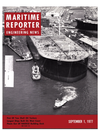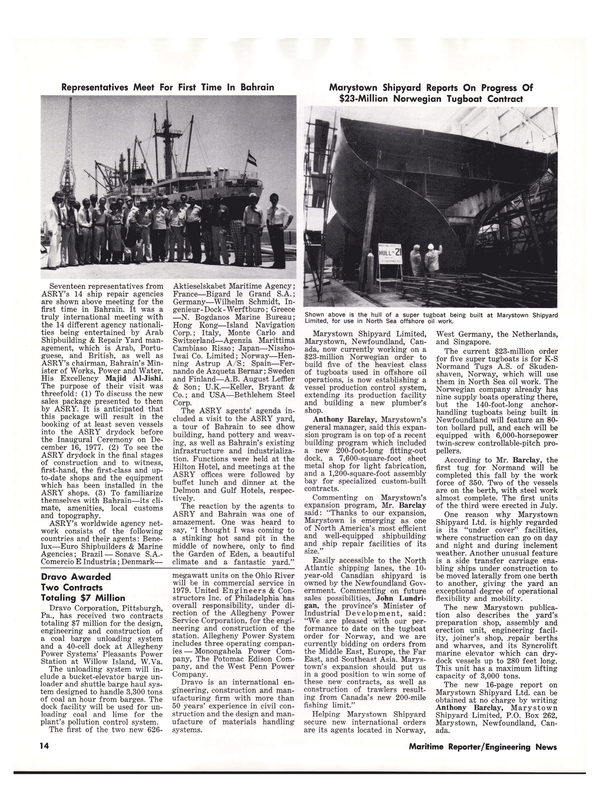
Role Of Ro/Ro Shipping In Dry Cargo Trade
The past two to three years have seen a continuing growth of interest in ro/ro vessels, with a relatively small but nevertheless steady stream of orders for this type of ship—both large and small — being placed with shipyards in Europe and Japan. Ro/ ro handling was first introduced onto the European short-sea trades 30 years ago, and the concept has been successfully applied since the mid-1960s on a number of long-distance routes, for instance on the North Atlantic and between Europe and Australia.
It is therefore rather surprising that it is only fairly recently that the changing conditions of international trade should have focused so much attention on ro/ro.
It is true to say, however, that the difficulties which have emerged from the rapid opening up of trades to the developing countries in the Middle East and elsewhere have highlighted the relative advantages of ro/ro visa- vis other transportation modes.
However, despite its apparent adaptability, the future of ro/ro is by no means assured. There is a consensus of opinion that the optimum advantage of ro/ro handling can only be achieved over short distances, and that it be- comes increasingly less economic over longer routes; so it is felt that with the completion of various port development schemes in the Middle East, in particular, its usefulness on any large scale may be only transitory.
Whatever the realities of the situation, the value of the ro/ro vessel in the present world market, the considerable ingenuity which is constantly being expended on design, and its evident potential for developing countries, where congestion is a perennial problem, more than justifies an in-depth assessment of its present and future role both in deepsea and short-sea trades. The purpose of the present survey is to examine the employment and operation of ro/ro vessels, highlighting costs and performance, as well as other important aspects of their competitiveness with other shipping types.
The HPD survey of "RO/RO SHIPPING: An Appraisal of its Role in Dry Cargo Trade," includes : The development of ro/ro as part of a widespread movement toward unitization, and a brief comparison of ro/ro with other modes of unit transportation— containerships, barge carriers, pallet ships; The growth of the ro/ro fleet and the impetus behind its development, identifying the main centers of interest in this type of tonnage, and the extension of operational patterns, which has had a fundamental influence on design; The various classes of ro/ro vessel, ranging from the shortsea combined passenger/freight ferry and pure ro/ro-cargo ferry, to the highly developed deepsea designs, including discussion of dimensions, speed, cargo-handling capability, etc., and considering the difference in employment for each of these types of vessel; The potential size of the ro/ro fleet, examining trends in newbuilding orders, and in the potential employment of contracted tonnage; An examination of the shortsea ro/ro operations, looking at the ownership of vessels, major routes and cargo types, and the progress which has been made in ship design to meet the demands of these trades, with special reference to Northern European operation ; A review of the major deepsea trades, and the vessels which have been built — or are being built — to serve them. Cargo capacity, vessel dimensions and other vessel characteristis are detailed in a systematic manner, and the contribution of ro/ro space to these trades, by comparison with cellular capacity, is discussed; The development of ro/ro services into congested ports, describing the onset of congestion and the usefulness of ro/ro handling and indicating the extent of ro/ro and other services into the Middle East and Nigeria; The cost of acquiring ro/ro vessels — with special reference to ro/ro cargo vessels, both deepsea and short-sea types — including discussion of newbuilding and second-hand costs, and comparing them with equivalent prices for containerships and general cargo vessels; The operational outgoings experienced by operators of ro/ro tonnage, including items such as manning, insurance, repairs and maintenance, etc., and offering comparison with costs for other vessel types, and The trading patterns of ro/ro vessels, examining vessel efficiency, possible shortcomings in this type of tonnage through examining their performance on various trades, and offering comparison with cellular and other tonnage.
"RO/RO SHIPPING: An Appraisal of its Role in Dry Cargo Trade" can be obtained at a price of U.S. $160 by writing to HPD Shipping Publications, 84 Brook Street, London W1Y 2LL, England.
Read Role Of Ro/Ro Shipping In Dry Cargo Trade in Pdf, Flash or Html5 edition of September 1977 Maritime Reporter
Other stories from September 1977 issue
Content
- Lloyd's To Class Two Large Crane Barges To Be Built By Mitsui page: 4
- Estimated Foreign Cost Of Two LNG Carriers $115.5 Million Each page: 6
- McAllister Brothers Name Robert Lounsbery Chief Operating Officer page: 7
- Lockheed Wins Contract To Evaluate Ocean Platform Candidates page: 7
- Bethlehem Steel Names G.Y. Marriner Manager San Francisco Yard page: 7
- AMPAC To Build Four Container Feeder Ships At Cost Of $92 Million page: 7
- MarAd Approves Title XI For Five Moran Tugboats page: 8
- SNAME New York Section Announces Program For 1977/1978 Season page: 8
- Willamette Awarded $15 Million To Modernize Alaska State Ferry page: 9
- Marathon Manufacturing Adds $61 Million To Drilling Rig Backlog page: 9
- NASSCO Building 188,500-DWT Tankers For Alaskan Oil Trade page: 10
- Exxon Begins Operating Remote Sea-Floor Production System page: 10
- Propeller Club Convention Includes Shipyard Panel page: 11
- MacMillctn Bloedel Orders Log Carrier At Cost Of $14 Million page: 12
- C-E Names Matthews Manager Of Contracts, Marine Power Systems page: 12
- Role Of Ro/Ro Shipping In Dry Cargo Trade page: 12
- Port Of New Orleans Presents Key To City To Egyptian Official page: 13
- Representatives Meet For First Time In Bahrain page: 14
- Marystown Shipyard Reports On Progress Of $23-Million Norwegian Tugboat Contract page: 14
- Dravo Awarded Two Contracts Totaling $7 Million page: 14
- Morris Guralnick Associates, Inc. Name Hubert E. Russell page: 14
- Canada's Newest Great Lakes Bulk Carrier Launched page: 16
- Todd Seattle Division Lays Keel For Royal Australian Navy Frigate page: 18
- Title XI Approval For Two IOT Subsidiaries page: 18
- Jerry D. Icenhower Named President Glitsch Cryogenics page: 18
- Hillman-Designed New Class Towboat Delivered To Exxon At Baton Rouge page: 19
- BP Invests $50 Million In Stolt-Nielsen page: 20
- Speakers Named For Weather Conference September 14-15-16 page: 22
- $45-Million Subsidy Repayment Approved page: 23
- Study Shows Worldwide LNG Production Increase —60 Carriers Needed page: 24
- Bethlehem Steel Subsidiaries Name Collins And Coulahan page: 25
- Gotaverken Converts Cargo Ship To Carry 32,000 Live Sheep page: 25
- Halter Marine Delivers Large Supply Boat To George Engine Co. page: 26
- Bethlehem Steel Shipbuilding Names Roland V. Danielson —Hollinshead De Luce Retires page: 26
- Perspectives On Third World Port Development page: 30
- APL Names Hubbard Senior VP Operations page: 31
- New National Supply Anchoring Windlass page: 31
- Shallow Water Maneuvering Trials Completed In Gulf page: 32
- Farrell Sale And Leaseback Agreement Approved By MarAd page: 32
- Delta Steamship Names Badger And Collins page: 32
- Gross Tonnage In ABS Classification Exceeds 100-Million Mark page: 33
- Airfilco Appoints Kevin McPherson page: 33
- CCN Of Brazil Launches New Type Bulk Carrier page: 33
- 51st Annual Propeller Club Convention And 1977 American Merchant Marine Conference Set For Galveston, Texas, Oct. 10, 11, 12, 13 And 14 page: 34
- Bulletin Describes Heavy-Duty Oil Filtration Systems page: 35
- Eight-Page Brochure Describes National's Fully Hydraulic Cranes page: 35
- Joseph Hurley Named President ITT Decca Marine page: 36
- Oceangoing Split Hull Self-Propelled Dredge Completes Trials In Gulf page: 37
- ITT Decca Marine Introduces 'Clearscan' New Radar Technique To Reduce Interference page: 38
- Todd Shipyards Los Angeles Division Lays Keel For First Of Six U.S. Navy Frigates page: 38
- MacGregor Slewing Ramps Successfully Tested page: 39
- Skagit Corporation Announces European Dealership Agreement page: 40
- FMC Marine & Rail Lays Keel For Ro/Ro Barge To Carry 374 Forty-Foot Truck Trailers page: 40
- Egyptian Shipyard Receives License To Build Willard Boats page: 42
- Bergeron Industries Names Captain Tatman page: 42
- Port Authorities (AAPA) 66th Annual Convention Set For Mexico City page: 43
- Lloyd's Register Completely Revises Rules For Marine Refrigerated Cargo Installations page: 44
- Tanker Design Change Approved By MSB page: 44
- Navy Contracts For Additional Years Of MARISAT Satellite Service page: 46
- Mitsubishi Receives Tug Barge Systems' License To Build page: 46
- Petro-Marine Names Murray Burns Manager Process Engineering page: 47
- Norshipco Dedicates New $5-Million Repair Pier page: 47
- COMSAT General Expands MARISAT Services To Entire Indian Ocean page: 48
- U.S. Lines Names Three In Operations page: 48
- Fetzner Named President Sun Trading & Marine page: 48
- Philippine Center Exhibit Highlights Filipino Seaman page: 49
- Henschel Announces New Steering-Failure Alarm page: 49
- Tulsa Port Of Catoosa Sets Tonnage Record page: 49
- Jane's Fighting Ships 1977-78 Revised Edition page: 49
- Stanford Research Awarded $271,000 For Firefighting Study page: 50
- Gulf Oil Trading & Transportation Announces Management Changes page: 51
- Renegotiation Board Erred In Computing Lockheed Steel Usage page: 51
- Pott Industries Names Miller VP Offshore Marine Services Div. page: 54
- Joseph R. Burgess To Head Central Pacific Shipping Agency page: 56
- Capt. James F. McNulty New Dean At Maine Maritime Academy page: 56
- Richard Daschbach Named Federal Maritime Commission Chairman page: 57
- Keene Brochure Describes Marine Discharge Control System page: 57
- Heavy Weather Ship Operation Subject Of Webb Seminar page: 58


